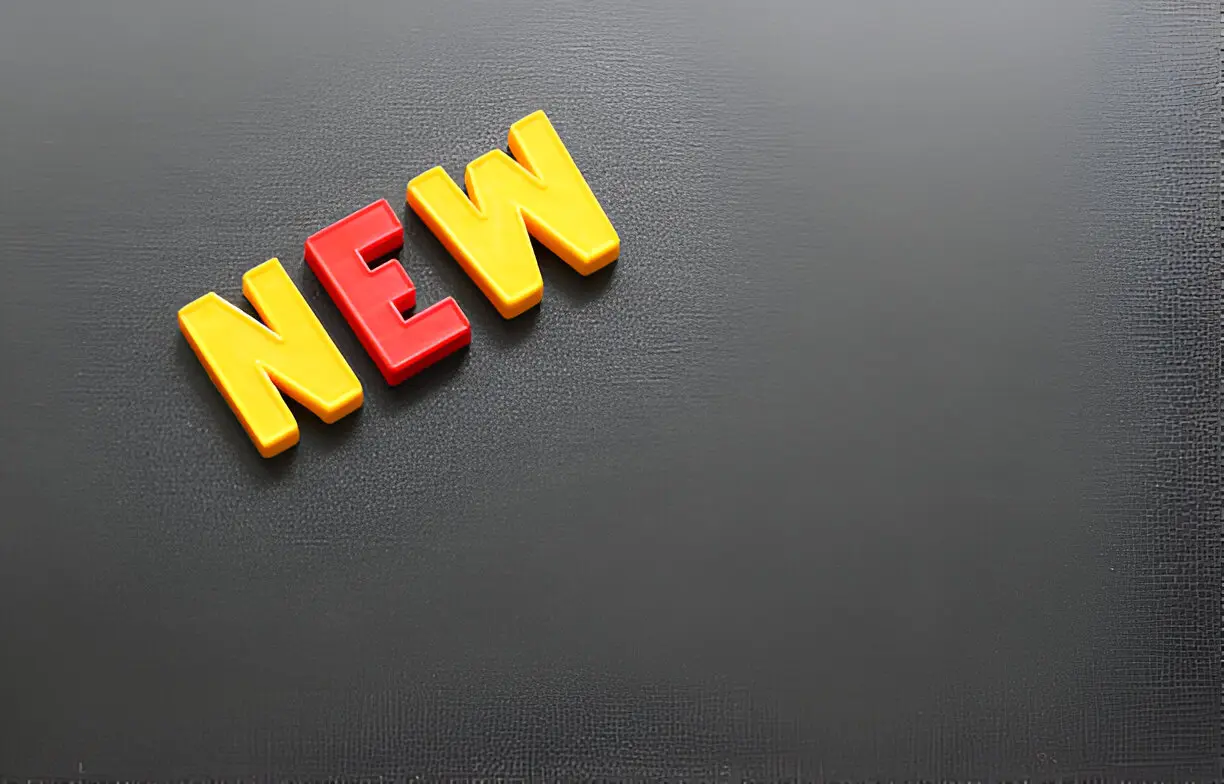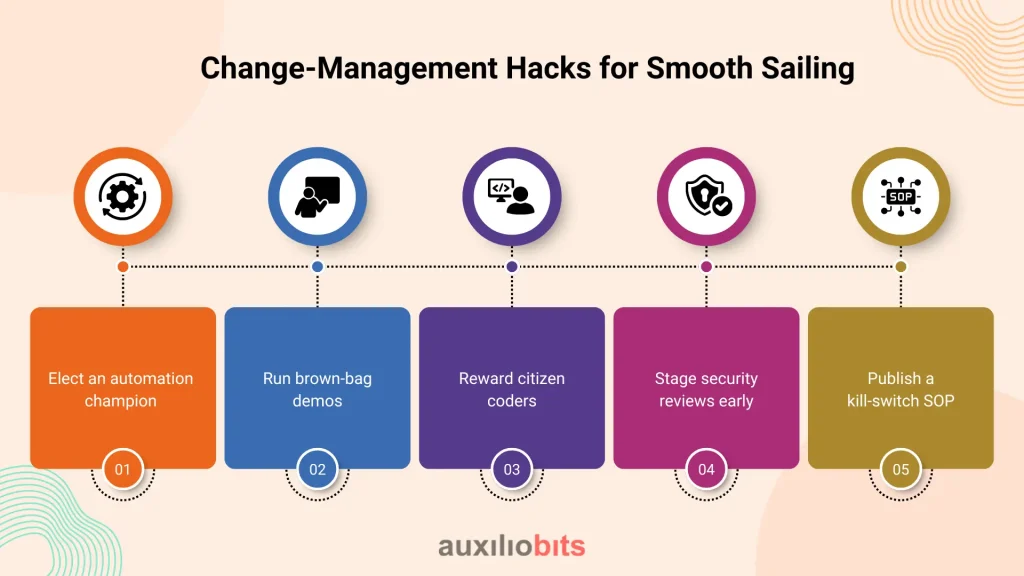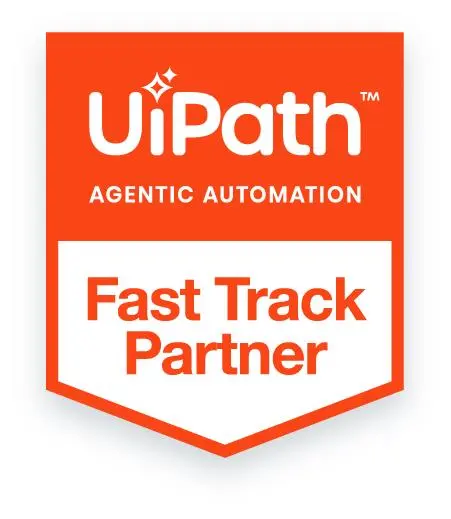
Key Takeaways
- Agents > Bots – UiPath’s new agentic layer turns static scripts into goal‑seeking inventory “brains” that predict stock‑outs, balance safety stock, and document every decision for audit.
- Autopilot + Clipboard AI Slash Manual Work – Highlight an email, hit Ctrl + C, and watch UiPath build a purchase‑order workflow automatically—cutting data‑entry time by up to 75 %.
- Data Fabric Creates a Single Source of Stock Truth – Virtual entities merge ERP, WMS, IoT, and e‑commerce data in real time, eliminating nightly ETL jobs and “stale quantity” disputes.
- 30‑Day Fast‑Track Gets You Live Quickly – A week‑by‑week sprint plan shows exactly how to sandbox, wire data, prototype agents, trigger events, and roll out KPIs without disrupting operations.
- Change Management Is the Secret Sauce – Elect champions, demo bots weekly, reward citizen coders, involve compliance early, and publish a kill‑switch SOP to keep your automation journey smooth and scalable.
Imagine this: Your warehouse talks. It tells you when shelves are running low, when a shipment might be late, or when a product’s about to expire. Not with beeps or dashboards—but through intelligent agents that think, act, and learn.
This isn’t science fiction. This is UiPath in 2025.
Once known for automating clicks and keystrokes, UiPath has now stepped into a new era—an era where automation isn’t just fast, it’s smart. And nowhere is this more game-changing than in inventory management.
Stock-outs? They’re predicted before they happen. Reorders? Automatically triggered based on live sales and supplier data. Cycle counts? Done with zero spreadsheets, zero drama.
UiPath’s newest features—like Autopilot™, Agent Builder, Data Fabric, and AI-powered document understanding—aren’t just technical upgrades. They’re a mindset shift for supply chain teams: from reactive to proactive, from data chaos to clarity, from human-heavy to human-smart.
If you’re still juggling Excel sheets, cross-checking stock levels manually, or emailing suppliers to confirm availability, this blog is your wake-up call. Because the future of inventory isn’t about more work—it’s about smarter automation doing the heavy lifting.
Also read: Why Is UiPath Integration with Chatbots and Virtual Assistants Non-Negotiable?
From Robots to Agents: UiPath’s New Brain for Inventory
Traditional bots are workhorses: they follow a recorded set of clicks and never look up. UiPath’s agentic layer, first unveiled at FORWARD VI and rolled into preview in April 2025, bolts a thinking brain on top of that muscle.
Agents ingest goals—“keep SKU A‑123 above a 14‑day cover”—and decide the path to victory on their own. They pull yesterday’s sales from Data Fabric, request a projection from AI Center, call a Salesforce campaign API, and finally choose whether to raise a purchase order or trigger a markdown. Each tool the agent touches is logged, version‑controlled, and auditable, so supply‑chain leads still pass SOX and FDA checks.
Why should inventory teams care?
- Predict before you panic – Agents read real‑time demand signals and reorder hours, not days, sooner.
- Shrink firefighting – Exception loops flag only ambiguous situations, freeing planners for strategic work.
- Keep the CFO smiling – Balanced safety stock lowers carrying cost while avoiding revenue‑killing stock‑outs.
Autopilot™ for Everyone: Your Voice‑Activated Stock Assistant
UiPath’s June 2025 release made Autopilot for Everyone a default entitlement.
Picture a buyer highlighting a supplier’s email that lists ten replacement parts. One press of Ctrl + C and Clipboard AI rips the messy text into a tidy PO table. Next, the buyer types: “Create a replenishment workflow for any SKU with less than ten days of coverage.” Autopilot spits out a Studio diagram in seconds.
Where does inventory management gain?
- Edge‑email ingestion – Let Autopilot read ad‑hoc shipping notices that never make it to EDI.
- Self‑service automations – Planners no longer wait for IT; they draft workflows in plain English.
- Teams & Copilot hooks – Trigger bots from inside chat, closing the gap between conversation and action.
Benchmarks from early adopters show a 75 % cut in manual entry for reorder lines and a two‑hour weekly gain in buyer productivity.
Agent Builder & Private Catalog: Crafting Domain Experts
The Agent Builder preview offers a drag‑and‑drop canvas where you stitch tools, prompts, and guardrails into reusable domain agents.
Blueprints worth cloning:
- Back‑Order Buster – Scans open orders every hour, checks supplier lead times, and recommends expedited POs.
- Shelf‑Life Sentinel – Cross‑references lot age with customer promise windows and schedules proactive markdowns.
- Supply‑Risk Radar – Feeds supplier names into a sentiment model and alerts when geopolitical chatter spikes.
Publishing to a private agent catalog turns these recipes into Lego bricks that citizen developers can snap into bigger workflows—no code, no drama.
Integration Service 2025: Plug‑and‑Play APIs for the Warehouse
Screen scraping is passé. Integration Service now lists 150+ connectors, with three game‑changers dropping in June 2025.
| New connector | Inventory super‑power |
| Salesforce Agentforce & Flows | Pipes promote demand into min‑max formulas in real time. |
| CrewAI | Sends pick‑and‑pack missions to collaborative robots. |
| Custom connectors in Solutions | Wraps legacy WMS APIs so planners can tap them without code. |
All connectors surface in Maestro™ alongside UI steps, letting one hybrid flow decide UI or API execution on the fly.
Data Fabric (Preview): One Truth, Zero Sync Jobs
Data Service has matured into Data Fabric, now in public preview.
Virtual entities mirror tables from SAP, Shopify, Snowflake, or IoT hubs, but robots read live data, not stale replicas. Agents can mash on‑hand stock, open orders, and sensor counts in a single query.
Key perks:
- Write‑backs – Cycle‑count bots update ERP quantities instantly; no overnight batch.
- ERD designer – Visualize warehouse → location , → bin hierarchies, so every automation speaks the same language.
- Security inheritance – Field‑level permissions flow through to consuming bots.
Early pilots shaved two hours off nightly ETL windows and killed “stale quantity” disputes.
Case Study Snapshot: Electronics Retailer
An electronics chain piloted Data Fabric plus Agent Builder in one distribution centre. Within eight weeks, the Back‑Order Buster agent cut emergency air‑freight spend by $180 000, and turns jumped from 7.1 to 8.3. The team: two citizen developers, one COE architect, and a supply‑chain intern. Hardware cost? Zero—the stack ran entirely in Automation Cloud.
Document Understanding 2025: Generative Extraction Takes the Wheel
Hand‑typed ASNs and multilingual packing slips wreck efficiency. The January 2025 upgrade swapped in GPT‑4o for the Generative Extractor, halving error rates on complex tables.
A receiving bot can now read 100‑page PDFs, pull line number, batch code, and quantity with > 92 % straight‑through accuracy, then raise discrepancies in Action Center.
Practical wins:
- Faster dock‑to‑stock – Goods are booked within minutes of arrival.
- Paperless audits – Digitized receipts feed Data Fabric, ensuring traceability.
- Zero‑shot onboarding – New supplier templates work on day one.
Disconnected Event Triggers: Robots That Wake Themselves
April 2025 merged Integration Service triggers into Orchestrator, birthing disconnected event triggers you configure outside any package.
Use cases:
- Shelf sensors push variance readings; a trigger launches a Cycle‑Count Agent.
- CSV uploads fire reconciliation bots.
- High‑CPU alerts pause low‑value automations during the month‑end close. Ops heroes can throttle or reroute triggers from a web console—no redeploy needed.
AI Trust Layer: Guardrails for Generative Inventory Bots
Generative AI is powerful but chatty. The AI Trust Layer adds context indexes, quota dashboards, and RBAC, enhanced in May and June 2025.
Highlights: H3
- Context Grounding – Inject your product hierarchy so agents never hallucinate SKU codes.
- Quota meter – Track storage and token spend per index.
- Solution integration – Indexes travel with Solutions, making dev‑to‑prod promotion painless.
Security teams cheer the secret‑less Entra ID handshake that rotates credentials automatically.
SAP Task Center × Action Center: One Inbox to Rule Them All
On 23 June 2025, UiPath shipped a native bridge between SAP Task Center and UiPath Action Center.
A mismatch between PO and ASN now appears as a single task in SAP Fiori for warehouse clerks and in Action Center for finance auditors—synchronized and secured.
AI Center: Set‑and‑Forget Forecast Retraining
Demand planning used to need data‑science babysitting. AI Center lets you schedule a weekly retraining pipeline; fresh data flows in, the model rebuilds, and production swaps without downtime.
Add the Insights dashboard to watch MAPE drift in real time and trigger alerts.
Road‑mapped extras include AutoML sweeps and peak‑season scenario generation.
Scorecard: Five Metrics That Shift Within One Quarter
| Metric | Pre‑UiPath | Post‑Adoption | Feature |
| Stock‑out rate | 4 % / month | < 1 % | Agents + Autopilot |
| Inventory turns | 6 | 8 | Data Fabric |
| Planner data‑entry hours | 20 h / week | 4 h | Clipboard AI |
| Cycle‑count effort | 1 FTE/site | 0.3 FTE | Disconnected triggers |
| Forecast MAPE | 18 % | 9 % | AI Center |
These are drawn from live manufacturing and retail pilots.
A 30‑Day Sprint Plan to Go Live
Ready to turn all these shiny new UiPath features into real inventory impact? This 30‑day sprint plan walks you through exactly what to do—week by week—to build, connect, and launch your first intelligent automation flow without disrupting business-as-usual. Think of it as your fast track from pilot to production.
Day 1–5: Sandbox & Quick Wins
Spin up Automation Cloud, enable Autopilot, and build a “Reorder Low Stock” bot.
Day 6–10: Data Plumbing
Connect Data Fabric to ERP tables; model the StockItem entity.
Day 11–15: Agent Prototype
Create Back‑Order Buster in Agent Builder and test against ageing orders.
Day 16–20: Trigger & Document Flows
Configure shelf‑sensor webhooks as disconnected triggers; deploy ASN extraction.
Day 21–25: Human Loop
Link Action Center with SAP Task Center; define escalation SLAs.Day 26–30: Rollout & Review
Move context indexes to AI Trust Layer; present KPI dashboard and lock phase‑two scope.
Change‑Management Hacks for Smooth Sailing
Even the smartest automation can fail if people aren’t on board. These change-management tactics will help you build trust, reduce friction, and turn your warehouse staff into automation allies—not skeptics. Use them to keep your rollout smooth, scalable, and bot-friendly from day one.

- Elect an automation champion per warehouse.
- Run brown‑bag demos every Friday—seeing bots book stock live converts skeptics.
- Reward citizen coders—gift cards for the first five Autopilot prompts that hit prod.
- Stage security reviews early—invite compliance to AI Trust Layer walkthroughs.
- Publish a kill‑switch SOP so ops can pause bots during black‑swan events.
The Road Ahead: Inventory That Thinks for Itself
UiPath’s roadmap teases Inventory Copilot, where agents negotiate spot buys with supplier chatbots, and Edge Orchestration that runs lightweight robots on industrial gateways. The trajectory is clear: warehouses that sense, decide, and act at machine speed.Adopt the 2025 features now, and six months from today, your planners will validate edge cases instead of crunching spreadsheets; twelve months out, the bots will be brokering discounts while Data Fabric syncs everything in real time. Inventory management is no longer about counting boxes—it’s about orchestrating intelligence.








